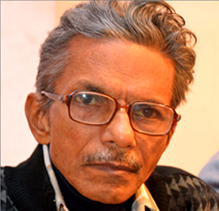
Mrinal Ghosh
He has written extensively on history and appreciation of Indian and world art. He has 23 books on various aspects of arts published by different publishers. He was associated with Anandabazar Patrika as an art critic for 27 years and regularly contributes articles in various important journals.
WOMEN SCULPTORS IN MODERN INDIA DURING 20th CENTURY
Mrinal Ghosh
Introduction
One of the greatest contributions of India in World Art is her sculptures. Staring from Indus Valley Civilization in 3000 B.C it developed gradually up to 1500 B.C. and then after a gap of about 1200 years it started flourishing from 300 B.C. and evolved with great fervor and devotion up to 1300 A.D. We do not know whether in these evolutions women artists played any role.
Modernity in Indian Art originated during the decade of 1850-s, when the British authorities opened art schools in different cities. There the method of art education was based on British Academic Naturalism. Some very proficient sculptors worked with this form. A few of them are Jadunath Pal (1938- nearly 2030-s), Rohinikanta Nag (1868-1885), Kashinath Mhatre (1876-1947), Ashwini Kumar Burman Roy (1882- ), Vinayakrao Venkatrao Wagh (1883-1958), Hiranmay Royshowdhury (1884-1962), K.Venkatappa (1887-1965) of Mysore, Balaji Basantarao Talim (1888-1970), Vinayak Pandurang Karmakar (1891-1966) et. al. Among them Debiprasad Roychowdhury (1899-1975) was the most celebrated sculptor, who despite his enormous skill in naturalist rendition showed some originality in expressionist execution also. We do not know whether any woman sculptor worked during this phase.
Painting had its neo-Bengal or neo-Indian school, where Abanindranath Tagore (1871-1951) was the pioneer. Since his series of paintings on Radha-Krishna, which he completed in 1897 owing to an urge to develop an indigenous form of modernity, the school flourished continuously up to 1930-s and made a great mark in developing an anti-colonial mode of modernity. Modern Indian sculpture had no neo-Indian trend. Only two sculptors could be identified who worked in traditional style due to their root in it. They were Giridhary Mahapatra and his son Sridhar Mahapatra (1902-).
Ramkinkar Beij (1906-1980) was the first artist, who developed in sculpture some sort of indigenous modernity and modernism. His sculptures from the early years of 1930-s till the end of 1970-s showed a luminous flowering of modernist Indian sculpture that could make an important position in international modernism. Ramkinkar had many students and followers. Among them there were only two women sculptors, about whom we will discuss later.
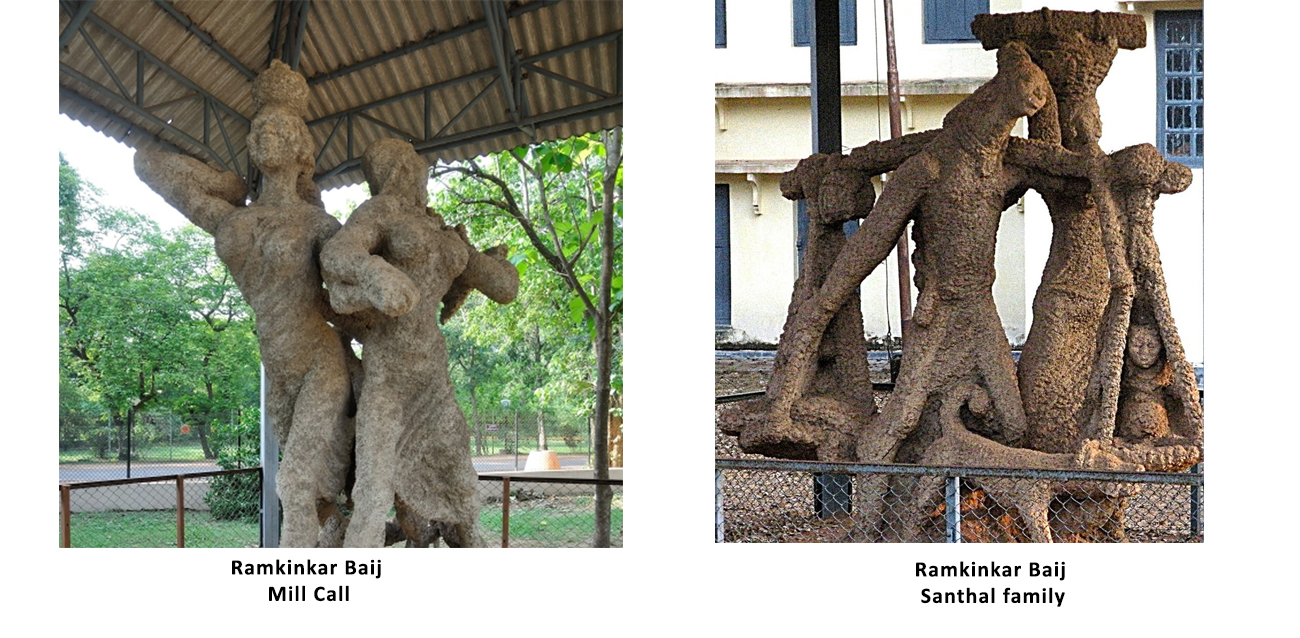
Women Sculptors.
Representation of women in modern and modernist Indian sculpture is very limited. Women who came to the field of artistic creativity mostly preferred painting. Sculpture is a laborious art-form that requires physical strength and enough time and money for execution, which is difficult for women artists to cope with mainly due to her familial responsibilities. So before 21st century women artists hesitated to come to creative sculpture. In 21st century girls have, however, coped with the problems and preferred sculpture and installation to express their socio-temporal commitment. In this article we will not go into the details of their creativity, as many of them are still in the formative stage. Our venture is to highlight the creativity of the women sculptors, who came to the field from 1940-s to 1970-s, who were born between 1920-s and 1950-s. There we will find a few of the great sculptors, who made very important and original contribution in the development modern and modernist Indian sculptures. Gradually we will come to their creative modes.
Lalit Kala Academy published an Artists Directory in 2006. There we find 1503 total entries. Among them 280 artists were women. Out of this 280 only 66 were women sculptors, rest were all painters or graphic artists. We can have a glimpse of the position of women sculptors from this. Kamal Sarkar did a very commendable research in computing the list of artists in his book Bharater Bhaskar O Chitrashilpi with a description of their life and works. In this book we find 328 entries, out of which 311 were men and only 17 women. Within this 17, there was no sculptor. Even the name of Meera Mukherjee was not mentioned. The scenario of working women sculptors is very much revealed from these documentations.
Trends of Modernity in Indian sculptures.
Surpassing the trends of academic naturalist form Indian sculpture till 1930-s, when modern and modernist Indian sculpture came to its own it tried to assimilate two trends. One was indigenous classical and traditional form. The other was Western modernist idioms. Very often this assimilation could not erase the marks of juncture, which debarred it from being the original expression. Ramkinkar could surpass this problem with his enormous original sensibilities. Among women sculptors Meera Mukherjee delved into such originality without being influenced by Ramkinkar. She was the first women sculptors in India, who could develop an original indigenous identity from the roots of tribal life and creativity. We will come to her a bit later.
The First Woman Sculptor of Modern India.
Who was the first woman sculptor in modern India? The matter is controversial. But we may consider the name of Kamala Dasgupta. She was the wife of the famous sculptor Pradosh Dasgupta. Before marrage her name was T.C. Kamala. Her father Dr. Paduval was a renowned civil surgeon of Kochin state. He could paint also. Kamala came to learn art at Madras Art School under Debiprasad Roychowdhury, who was the principal there. She joined the school in July of 1934 six months after Pradosh Dasgupta. There she was one year junior to Pradosh. Pradosh Dasgupta was born in 1912. So Kamala’s year of birth may be taken as 1913, though we are not sure about it. They married in 1940. Kamala was a member of Calcutta Group (1943-1953). But her sculptural creations were limited within portrait sculpture only. Pradosh Dasgupta writes about her in his book: Smrirtkatha Shilpakatha – Calcutta Group : ‘Kamala had shown her skill in portrait sculpture. Her works had been awarded in many all India exhibitions. But it is true that she had worked in a very limited space, as did the famous French sculptor Despiau (1874-1946)’. After this Dasgupta has spoken about the condition of woman sculptor in our country. He writes: ‘The number of women sculptor in our country is very minimum. Kamala is the senior most among them. Girls of our country like more to paint. Acquiring skill in sculpture requires much of physical labor, which our girls cannot stand due to two reasons. Firstly, they do not have that much physical strength. Secondly, where is their time? All their times are bound to their household activities. In case of Kamala also I have seen such obstacles.’ Here we can present two images of Kamala’s head study. One is of Pradosh Dasgupta. Other, the face of a girl named Soumini. These two woks prove her skill and sensitivity.
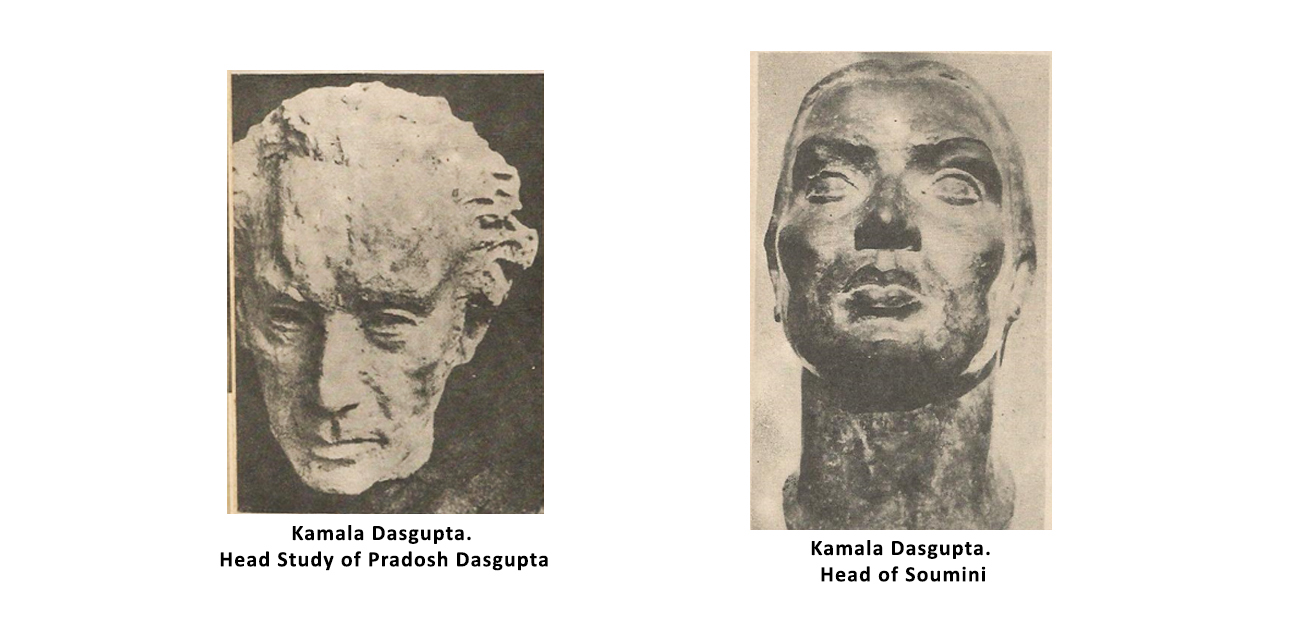
There was another artist in Calcutta, Arjun Roy, almost equal in age with Kamala. She was born in 1914. She used drift wood, natural root and branch formation as the basis of her form. She made solo exhibitions at Calcutta in 1956, 61 and 73, at Delhi in 1959. She was awarded Sunandini Memorial Medal 1972-73. We can see one of her works. At present she is almost forgotten.
Ira Choudhury (1916), wife of famous sculptor Shankha Chowdhury was a ceramic sculptor from Baroda. In her first life she was trained in Santiniketan. In 1959 when the sculpture department of Baroda expanded to include ceramics Basab Barua, an accomplished ceramist took charge to teach and organize, Ira Chowdhury being inspired by Basab Barua took ceramics seriously and worked a greater part of her life in this medium.
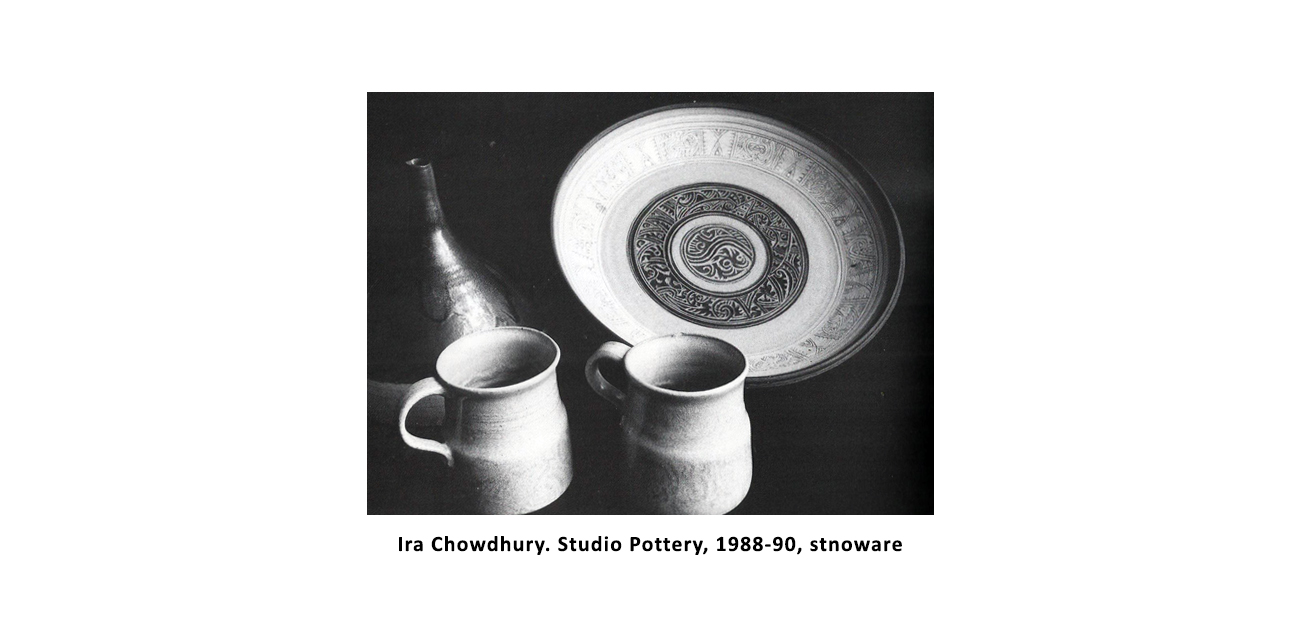
Leela Mukherjee (1917), wife of celebrated painter of Santiniketan Binodbehari Mukherjee (1904-1980) practiced sculpture. She was trained in Kala Bhavan, Santiniketan under Nandalal Basu from 1942 to 48. When her husband Binodbehari moved to Kathmandu in 1949, Leela went with him and learnt the art of wood and stone carving under his friend, the eminent Nepali artisan Kulasundar Shilakarmi She made one man show in Delhi 1957, 58, 70 and 77, at Calcutta 1958, Bombay 1976. She was art teacher in Welham Prepatory School at Dehradun for 23 years. As a sculptor she was also not much remembered in public memory. We may see one a few of her sculptures.
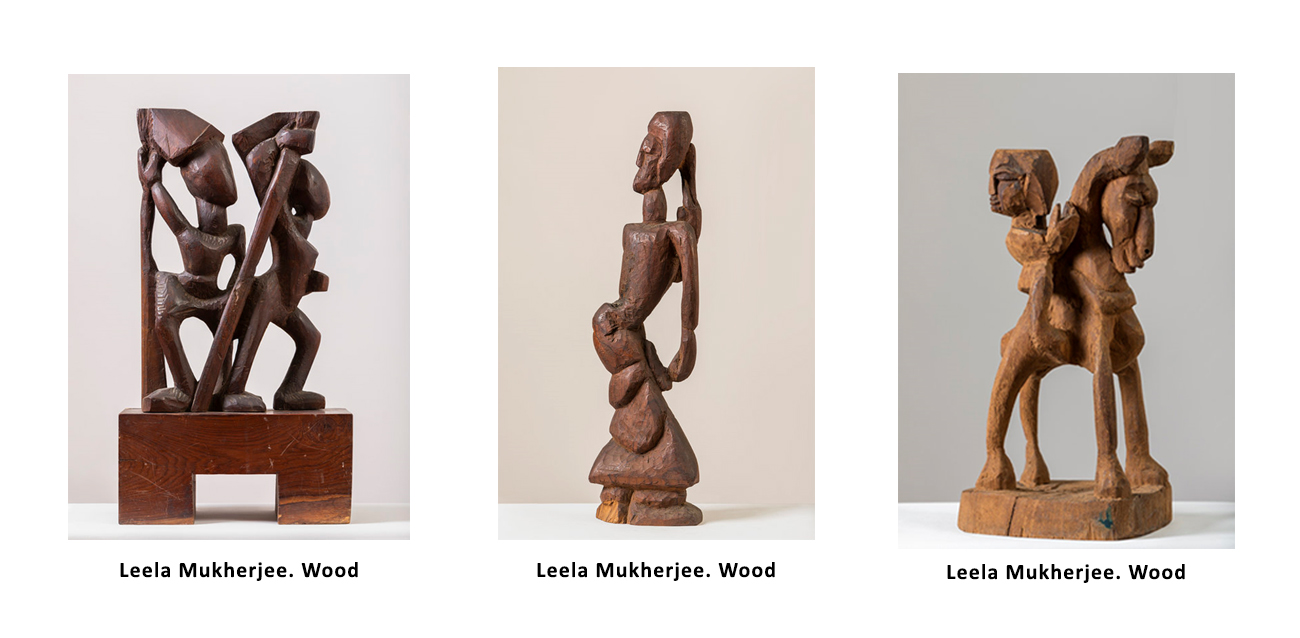
Women sculptors of 1940-s
Among the sculptors who were born in 1920-s and came to the field of their creativity during and after 1940-s there were two very important sculptors, whose contribution was immense. First we will speak of Meera Mukherjee (1923-98).
Meera Mukherjee
In modern Indian sculpture position of Meera Mukherjee is just after Ramkinkar. She has not only made some sculptural forms, she unfolded a visual philosophy that highlighted the spiritual values of India. She derived her forms from tribal sculptures, particularly the tribal artisans’ technique of bronze casting but elevated it to a classical musical sensibility. When there was a crisis in modernist Indian sculpture regarding proper assimilation of local and global forms, when excess of Western modern and modernist forms were being copied in the name of modernism, Meera Mukherjee showed the way, how Indian sculpture may be connected with the folk and tribal creative values. She will be always remembered as a pioneer in this field.
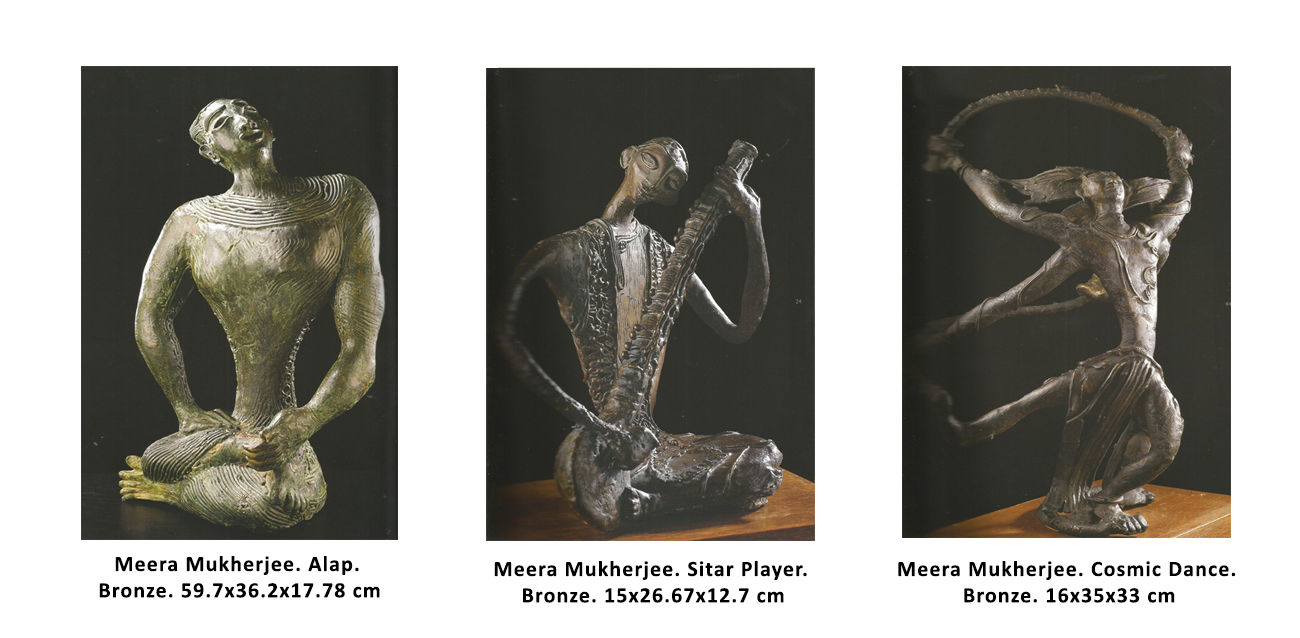
Meera had to struggle hard to come to her artistic creativity and to be a sculptor her journey was tedious. So her success proves her immense dedication and shows why it is difficult for a woman, particularly in India to practice the art of sculpture. In Calcutta her first art training was at ‘Indian Society of Oriental Arts’. But she was not satisfied with the past-mongering of this institution. She was then forced to marry. After marriage she went to Delhi. There she took admission in Delhi Polytechnic in 1947. After completing the course in 1951, she came to Santiniketan and learnt painting to the Indonesian artist Affandi (1907-1990). She could have some idea of Eastern philosophy of Art and Aesthetic. She went to Germany in 1953 and studied at the Akademie der Bildenden Kunst in Munich up to 1956, under Prof. Glethe Malerei in painting, under Prof. Stony Stadler and Prof. Heinrich Kirchner in Sculpture. She also learnt etching under Prof. Theirman Radierkunst and Lithography under Mr. Herrn Lowasser.
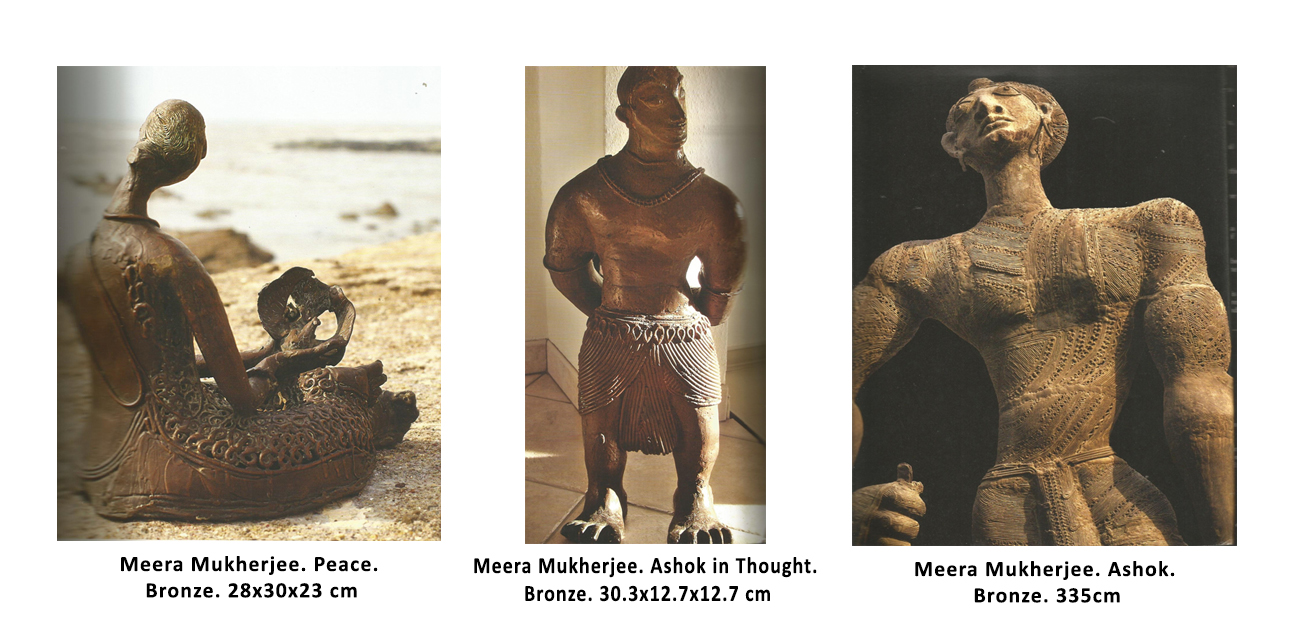
Returning to India she was hesitant about her own style and from. One of her Professors in Germany told her, being an Indian, the land of sculpture, why had she come to West to learn sculpture. This remark made an imprint on her. She realized, all the norms and forms that are being practiced in India had no further possibility. She had to find a new way for her expression. She could find, tribal sculpture is a very much living tradition in India, which has not been much explored by the modern artists. She tried to survey that field. In 1960 he went to Bastar and met the Gharua craftsmen. She worked there as apprentice for one year. Then she visited the classical bronze sculpture centers of Bangalore and Tamilnadu. After this visit she worked with three tribal craftsmen. They were Maral tribes, the Rana tribes of Mayurbhanz and the Malhores of Hazaribagh. She documented all these experiences in three books. First was the Folk Metal Artisans, published in 1964, second Gharuas of Bastar published in 1975 and the third Metal Craftsmen of India published in 1980.
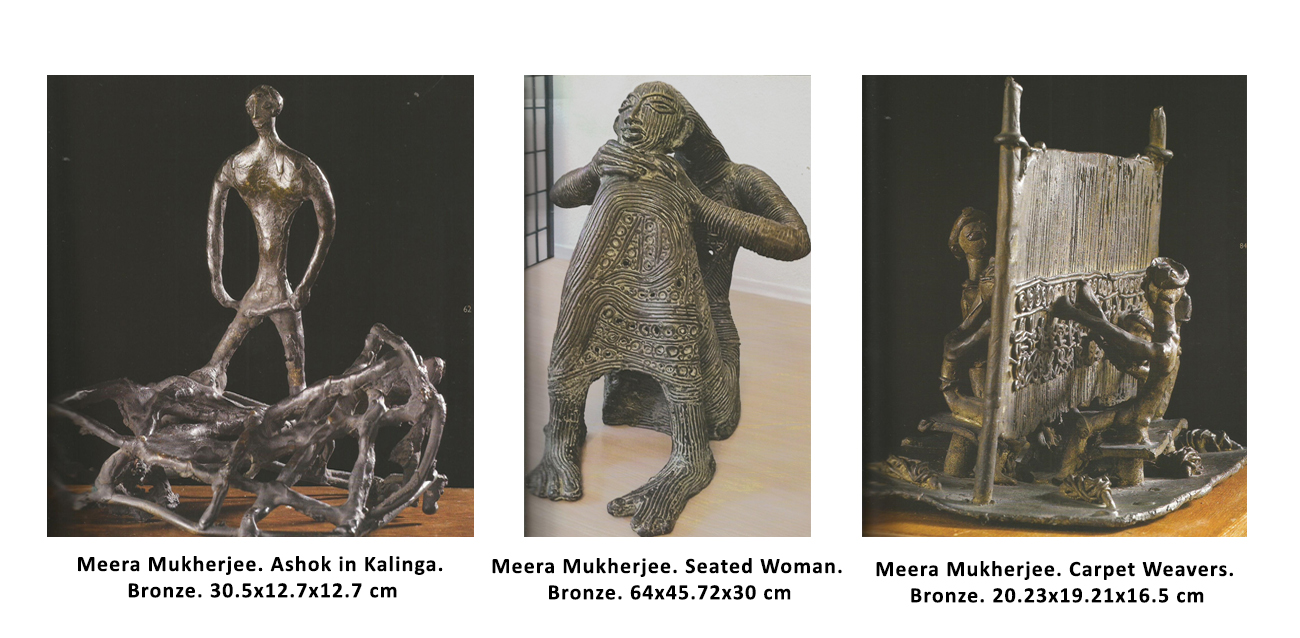
She did not stop merely by knowing the technique. She searched for the philosophy behind the creations of these craftsmen. She explored the myths and popular faith and named these craftsmen, who had been working since the time immemorial as Vishwakarma. She complied all her research in a book Vishwakarmar Sandhane, which she published herself in 1993. In this book she has revealed her deep faith in Buddhist philosophy and shown that these Vishwakarma craftsmen through their creativity explored the Buddhist vision of unification of this life with the entire universe. She has written: ‘These Vishwakarmas wanted to bring this vast universe within a limited measure or circumference. … Their intension was to touch or realize everything through consciousnesses. (P-88). Her own sculptures are based on this philosophy. After this she had freed her life from all familial bondages and devoted all her time in her creativity, sculpture and painting. She deeply loved Indian classical music, also practiced it herself. Her sculptures reflect this musical sensibility.
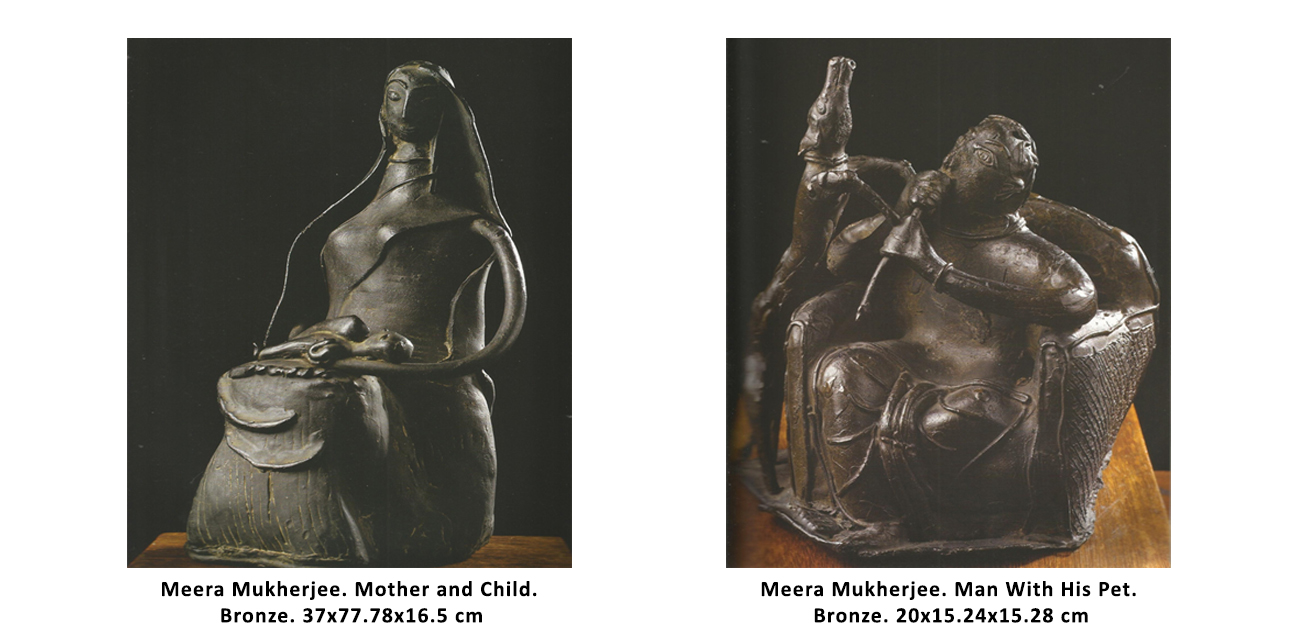
The journey with her own sculpture that she started in 1960 continued till the end of her life in 1998. The American feminist art historian Linda Nocklin published a lengthy essay in the journal Art News in 1971, which was titled ‘Why Have There Been No Great Women Artists?’ It will not be an exaggeration to say that Meera Mukherjee negated this assertion. As a sculptor she was really great. We will see some of her sculptures.
Piloo Pochkhanwala.
Piloo Pochkhanwala (1923-1986) was a wonderful woman sculptor of our country. She was a person of entirely different profession. She had no academic training in sculpture. After graduating in commerce she joined in the advertising field. Then how did she turn to sculpture? Let us listen from her own words. She said: ‘In 1951, I went to Europe in connection with a commercial assignment. I was then in the advertising field and had no thought of becoming a sculptor. Of course, once abroad, I took the opportunity of visiting the major museums. I did take the vast collections of paintings, but every time I looked at the major works of modern sculptors I felt struck by a visual bolt.’ She then added: ‘I was mortified by the sculptures because I was seized by the fear of the challenge of tackling something so difficult. I suppose the mind was sorting out the message that was beginning to take shape.’ (Monograph on the artist published by Lalit Kala Akademi).
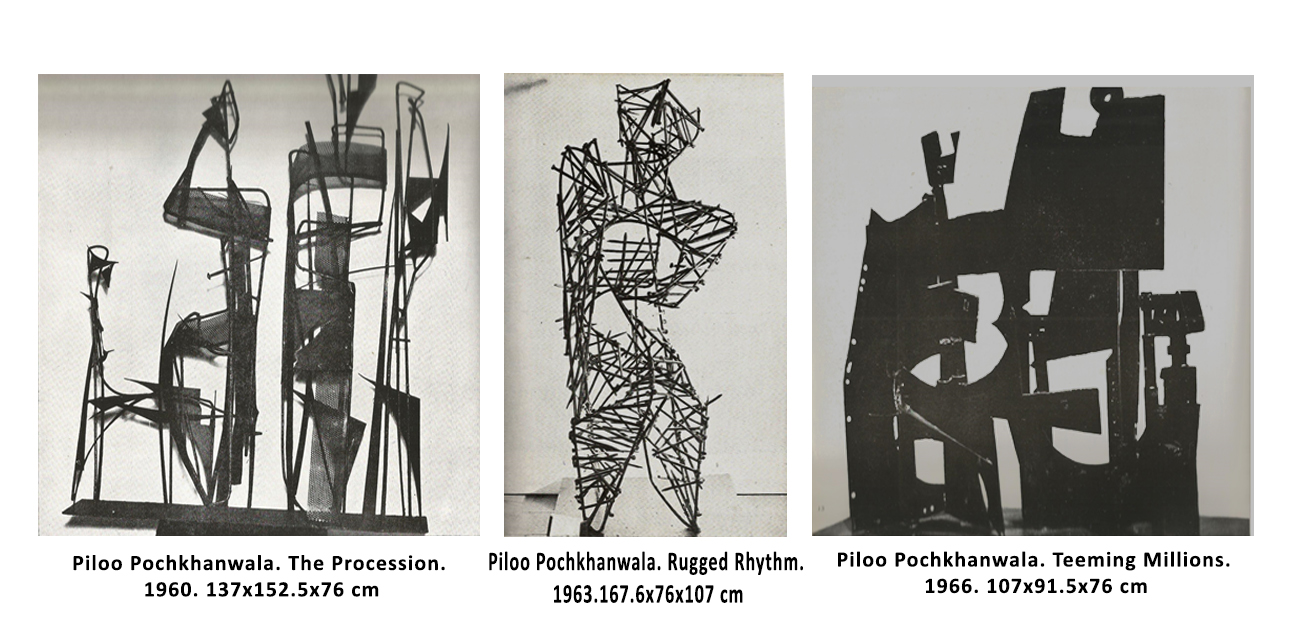
From this inspiration Pochkhanwala came to her own sculptural creativity. During the beginning of 1950-s Europe was surging towards new creativity of sculpture. In the sculptures of Brancusi, Henry Moor, Barbara Hepworth or Hans Arp there was a trend of three dimensional fullness of form. That trend was gradually changing in the sculptures of Giacometti, Germain Richier, Theodor Roszak, Joan Miro, Max Ernst, Luciano Minguzzi, Reg Butler, Lynn Chadwick, Eduardo Paolozzi, Bruno Giorgi, Norbert Kricke et.al. Sculpture turned to be what Giacometti once called ‘scribbling in the air’. Pochkhanwala was attracted by this trend of sculpture. She was not interested in the conventional forms, where sculpture is created in additive or subtractive method. Her intension was to create sculptural form out of apparently unaesthetic or discarded elements, though at the beginning she made some figurative pieces also through transformation of the realistic form with some influence of Henry Moore or others. This trend was prevailing in her works of 1950-s.
During 1960-s she came out of this conventional form. She tried creating form by mechanically adding metal scrapes or unused, thrown away metallic rods or pieces. An example of such work is Rugged Rhythm of 1963. She created the form of a standing man with mild steel rods and nails joining them through welding. It was a grotesque figure that contains more void than solid expressing an existential torment. She tried with such expressionist form at this stage that generated from some sort of socio-temporal commitment.
Her forms changed from 1960. A sculpture of this year is significant in this respect. The title of this work is ‘The Procession’. She constructed the sculpture by joining in welding large pieces of iron sheets and perforated iron nets. The subject is – a few persons are walking in procession. Construction of sculpture with scrap metal is very popular today. But the sculptors of that time were not much convergent with this technique. Pochkhanwala may be called the pioneer of this scrap-metal technique in our country. As the concept of this sculpture we see a kind of rebellion among the persons of emaciated physique, who may be in procession to protest against some odds. Another sculpture of welded steel titled Teeming Millions constructed in 1966 also reveals a more or less similar concept. The artist brings a sensation of unlimited within the limited. Here her imagination of creating the void within the solid is also exemplary.
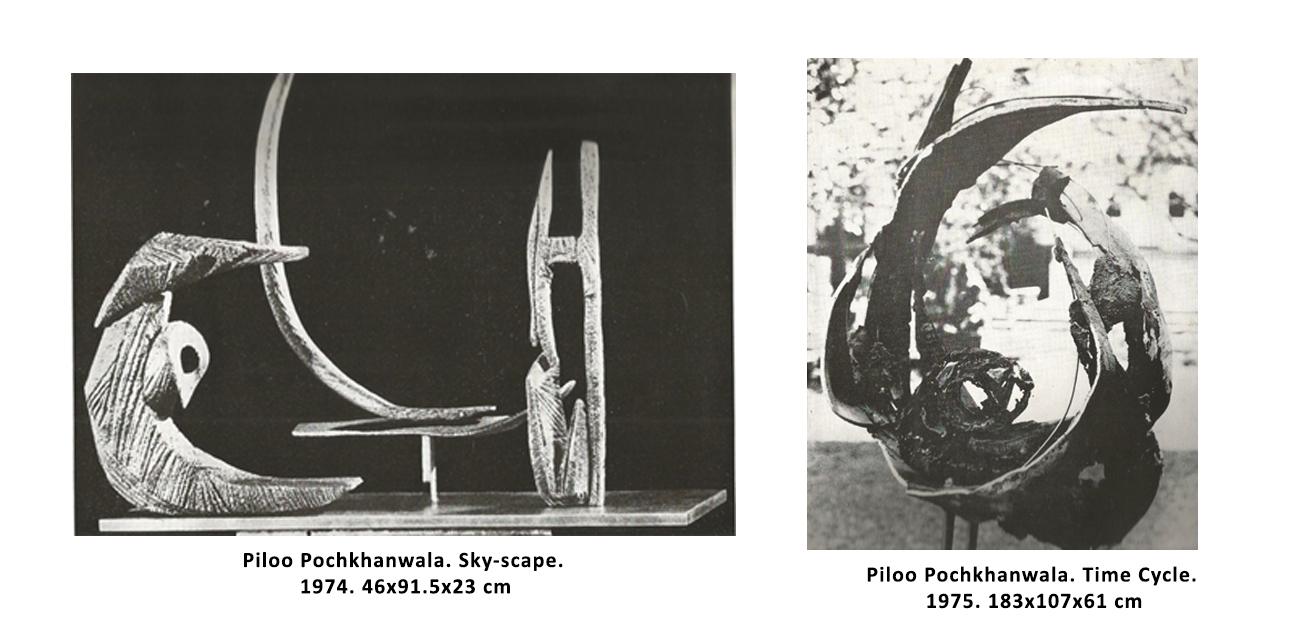
In the decade of 1970-s her sculptures took a new turn. By joining the fragments she tried to bring out a kind of lyrical rhythm. As if the dream of light and sky appeared through analysis of the darkened world. Let us see a composition of 1974 titled Sky-scape constructed with aluminum alloy, which is totally abstract. The composition divided in three parts is positioned on a platform. In the left end is placed a curved surface, on it is placed a triangular solid form. In front of the curved surface, placed in the middle position, there is a semicircular form. The curve is placed on a horizontal elongated form, in the center of which there is an elongated negative space. In the right end there is a vertical form. In the middle of which there is a perforated void. With the assemblage of these three abstract or semi-abstract forms, the artist has endeavored to construct a skyscape, an undefined landscape of the sky, with a tension between rhythmic beauty and mysticism.
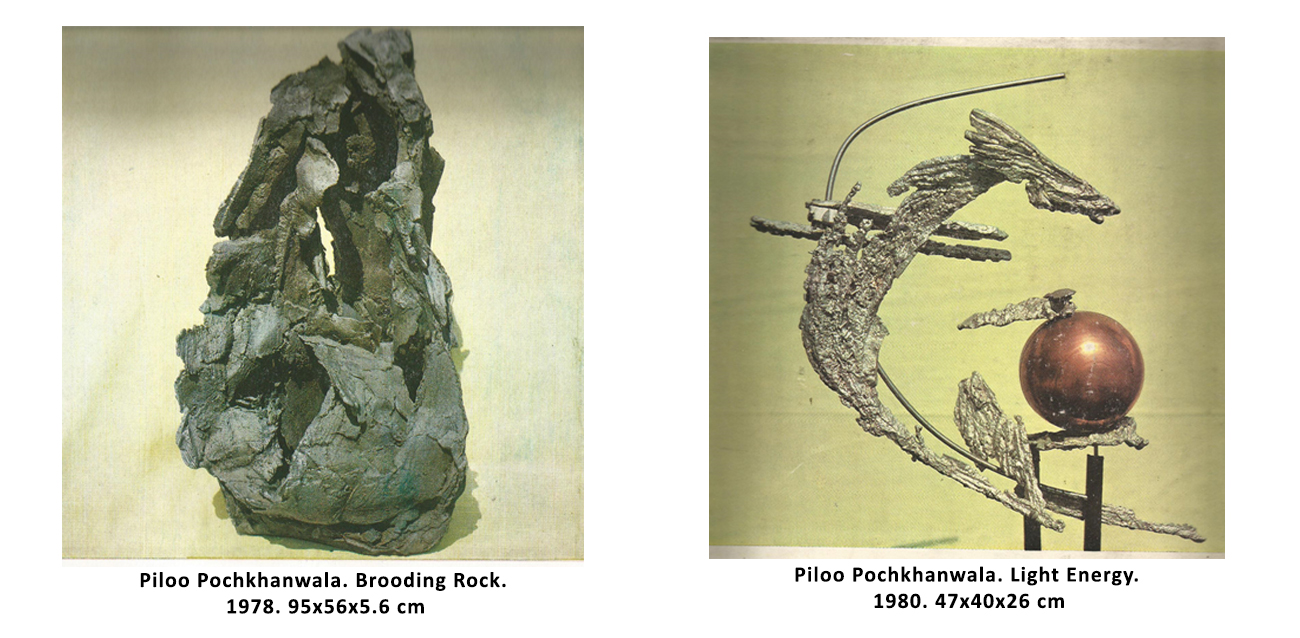
Time Cycle of 1978, a construction fabricated with aluminum alloy is an abstract piece. It is a nearly circular wheel placed on two vertical bars. The curved form is open ended with a whirl. The artist has endeavored to symbolize the dynamism of the universe through a static whirling form to represent the spiritual idea of dynamic time. From social commitment she now elevates her form towards spiritual philosophy. She transforms inanimate lifeless matter into life. Brooding Rock is an aluminium alloy and aluminium sheet construction of the same year 1978. The uneven rugged surfaces of a hill like structure rise up from an expanded base towards a pointed apex. Within the solid structure she brings a relief, when she creates a negative form, a hole-like void, almost at the centre. Brooding rock may be a symbol of brooding humanity.
Reaching 1980 the works of the artist oscillated between reality and transcendence. The work Light Energy of 1980, constructed out of aluminum alloy and copper appears to be a reflection of that transcendence. The Fossil of 1980, a copper-bronze composition and Execution of 1981, a ceramic and mild-steel construction reveals two opposing concepts. The first is an abstract form of transcendence; the second is concerned with the deep depression of dilapidated humanity. In Execution she presents two distorted brooding primitivist expressionist faces representing tormenting cry of humanity. (The image is not presented.) The other two images Lacuna (Aluminium, 1974) and Flight (steel) are wonderful endeavors of abstracting the natural rhythm.
Primitivism was the basic root of Pochkhanwala’s form. She has used primitivism in two trends of her expression, sometimes in figurative, sometimes in abstract. Often she has delved deeper into the dark gloom of humanity, often soared above the worldly real to depict the universal rhythm of the transcendence. Apart from her sculpturs, she was a very imaginative designer of theatrical set. Her sets for the theater Tughlak of 1970 and Dostoevsky’s Idiot of 1977 were memorable works. She made ten solo shows between 1955 and 1982, received Lalit-Kala Akademi’s national award in 1979. Her contribution in post-1960’s modern Indian sculpture is immense.
Reba Hore.
Another important woman artist of 1940-s was Reba Hore (1926-2009). She was mainly a painter and worked in a very personal expressionist style with a social commitment. She occasionally did sculpture in terracotta also out of pleasure. The subject of her sculptures was mainly human faces primitivist in expression with a rough and rugged texture. Out of this darkened expression the artist used to bring out an enlightened vision.
Among the other women sculptors of forties there were Usha Rani (1923) of Jaipur, Savi Prakash (1924) of Delhi, Aruna Vinayak Purohit (1926) of Mumbai and Sudha Arora (1926) of Lucknow / Delhi.
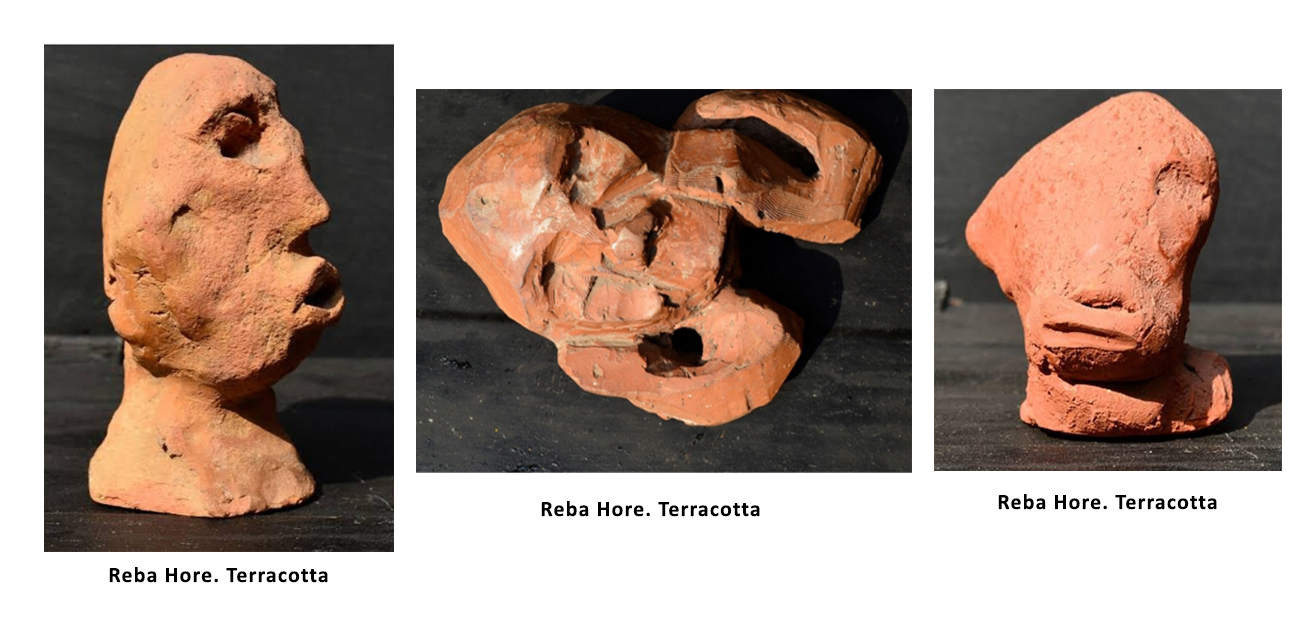
Sculptors of 1960-s
Navera Ahmed- Among the sculptors of 1960-s we like to mention the name of Navera Ahmed (1930-2015), though after independence she did not belong to India. She is the first and celebrated woman sculptor of Bangladesh. She was born in Calcutta in 1930. His father Said Ahmed was in Calcutta in connection with hir service. Navera’a school education started here. She passed Matriculation from Loreto School. After independence her father was transferred to Coomilla of Bangladesh. Her college education was in Coomilla and Chattagram. In 1950 she went to London. Her education in sculpture was in London, Italy and Paris. From 1956 to 1961 she was in her country, then East Pakistan. In 1961 she went again to Europe and remained there for the rest of her life. The sculptural works that she did during her stay at home and the works of rest of her life show how Navera assimilated her indigenous popular forms with Western modernist expressions. We mention him as an important woman sculptor of this subcontinent. Let us see some of her sculptures.
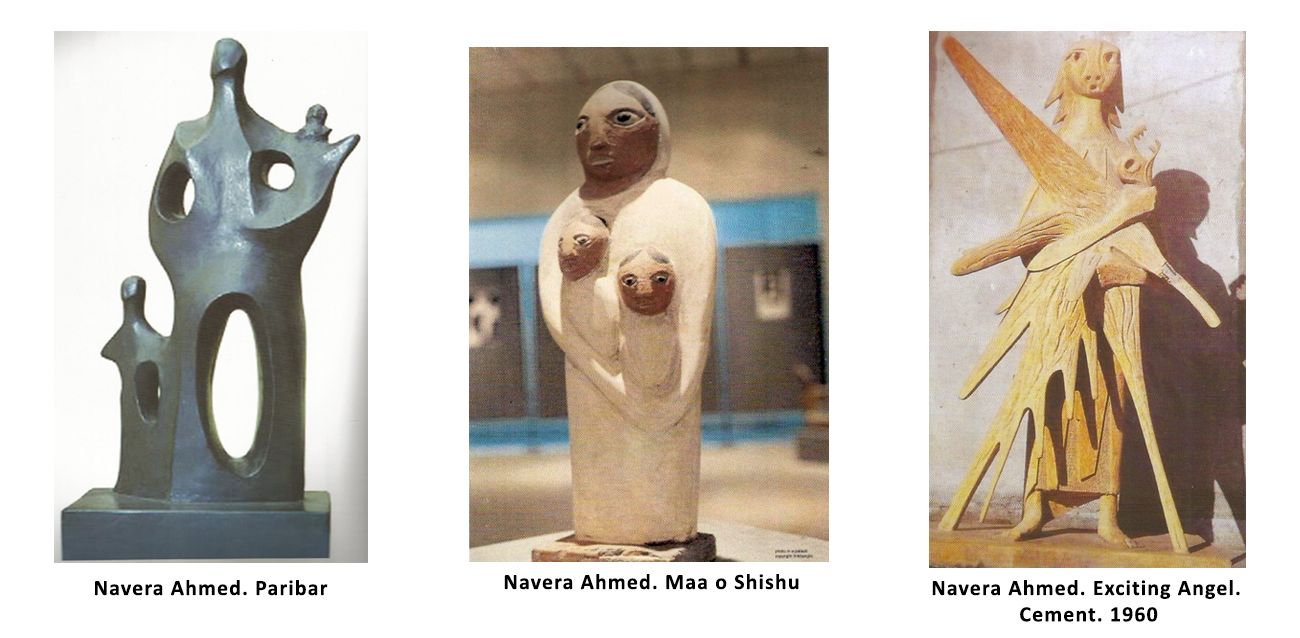
Uma Siddhanta (1933) is a very important woman sculptor of 1960’s from Kolkata. She was admitted to the sculpture department of Government College of Arts, Calcutta in 1951 and got Pradosh Dasgupta as her teacher. There was a very good relation between the teacher and his students of sculpture in Govt Art College even after he departed from the college till the end of the life of Dasgupta. Some of the sculptures of Uma Siddhanta of 1950’s showed some influence of her teacher. She came to her original form from after 1960. She worked in various styles and expressions, primitivist, expressionist and classisistic. In the core of her expressions always there is rebellious social criticism. Let us see some of her sculptures. She has experimented with various forms, both Western and indigenous. She tried with paintings also. Her water colors on bettle-nut burk are very innovative experimentation. Example of one such painting is presented here.
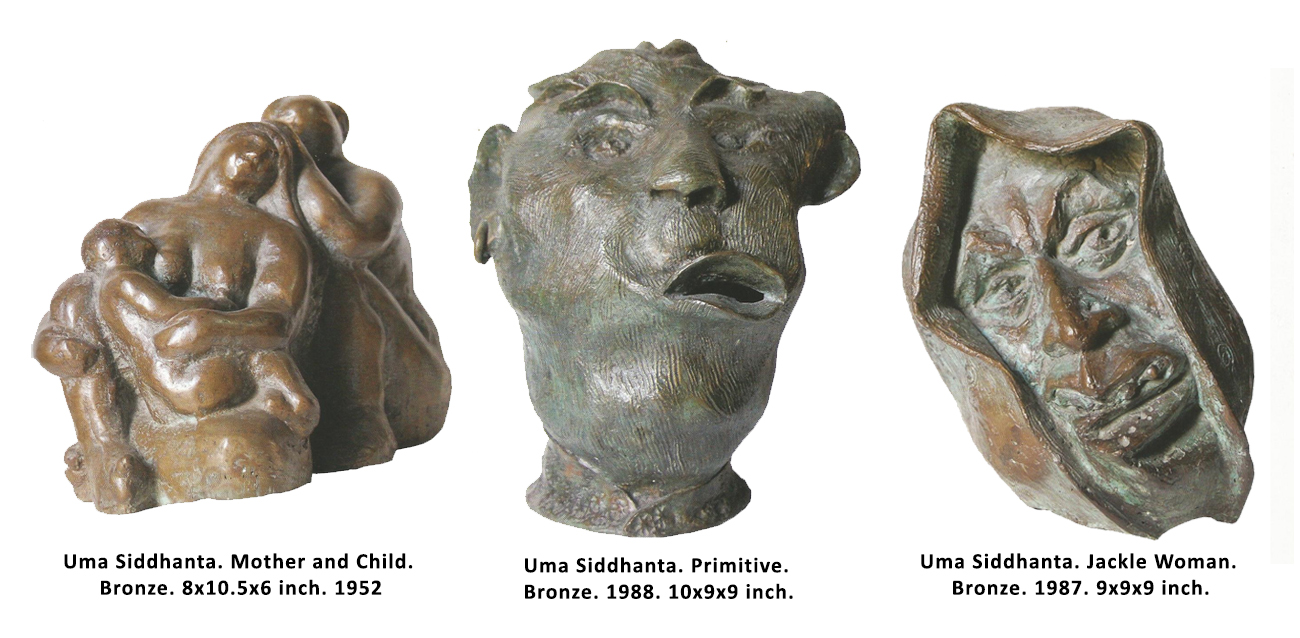
Jyotsna Bhatt (1940) was an important sculptor of Baroda. She made diploma and post-diploma in sculpture at Faculty of Fine Arts Baroda in 1961 and 1969 respectively. She got seriously interested in Ceramics during her stay in New York with her husband Jyoti Bhatt. There she made a certificate course in Ceramics and Pottery in Brooklin Museum School, New York in 1966 and worked there with a scholarship during 1965-66. She made her first one person show in New York in 1966 and again in New Jersey in the same year. She got AIFACS award in 1971. In her creative sculpture Jyotsna preferred a separate stream other than cerebral modernist pure form and utilitarian pottery. She opted for toy like animal sculpture, especially cats, for interior living spaces. As a domestic animal benign, cute cats are very dear to house hold people. Jyotsna’s sculptures deal with the animal. She also sculpts flowers, pots and other house hold decorative elements that create a soothing and pleasant atmosphere. Here are some of her works. Some other sculptors of 1960-s are Rita Sinha (1936) of Delhi, Harbhajan Sadhu (1935) of Punjab, vimla Bist (1937) of Ahmedabad / Lucknow et.al.
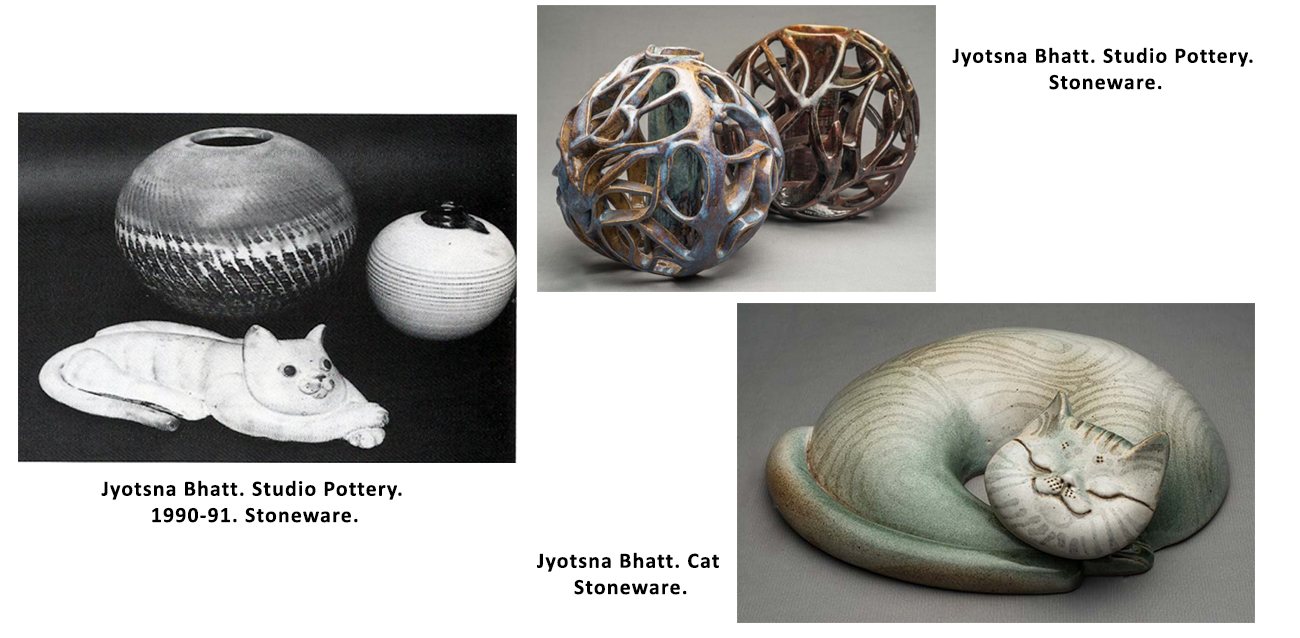
Sculptors of 1970-s.
The sculptures of 1970-s were an extension of that of sixties. Yet there were one or two women sculptors who opened new avenues.
Under the guidance Ramkinkar at Kalabhavan, Santiniketan many sculptors emerged. Among them there were only two women sculptors who could make significant mark. They were Kiran Barua and Kiran Dixit (Thapar). Both were born during middle of 1940-s.
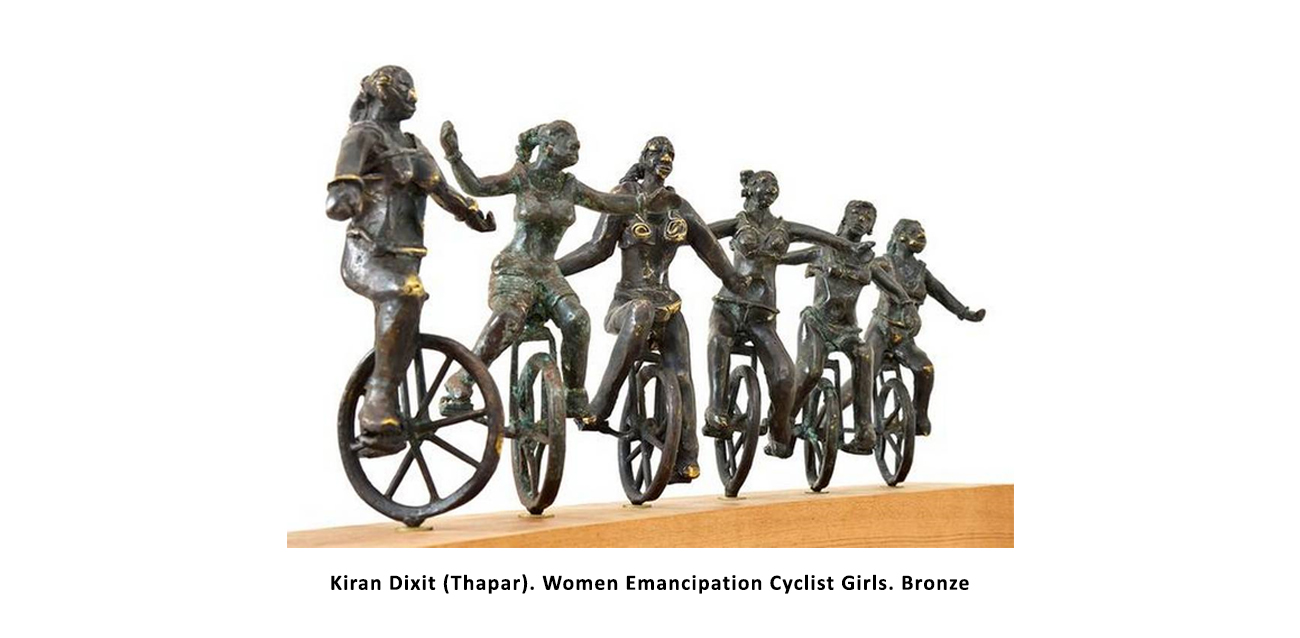
The centenary exhibition of Kalabhavan during December 1918 showed only one sculpture of Kiran Barua. It was a naturalistic-impressionist presentation of the bust of a melancholic man.
Kiran Dixit (Thapar) after completing her training at Santinikatan in 1968, went to U.K. and established herself as a sculptor there. After living there for three decades she came back to Santiniketan in 2000 and is now living there and working regularly. Cyclist girls, man and woman are some of her preferred subjects. There is a remote reflection of the tradition of Ramkinkar in her works.
Latika Katt (1948) is also a baroda-based sculptor. She made her graduation from Benaras Hindu University and masters from M.S University, Baroda. One of the characteristics of Latika’s sculptures is that she does not want to be dictated by the nature of the material of the sculpture, rather prefers to control its character to her own aesthetic need. She once said: ‘I wish to work on material, not to be worked by them’. (Catalogue, India-Japan sculptors camp, 1988-89, IPCL, Baroda). This is a characteristic of modernist sculpture. In her forms she inscribes an uncanny sensation of existential void that rules over the possibilities of life. Her expressionist disintegration of form often touches the surrealist chord to project the silent protest against decay of human values. Let us see a few of her works.
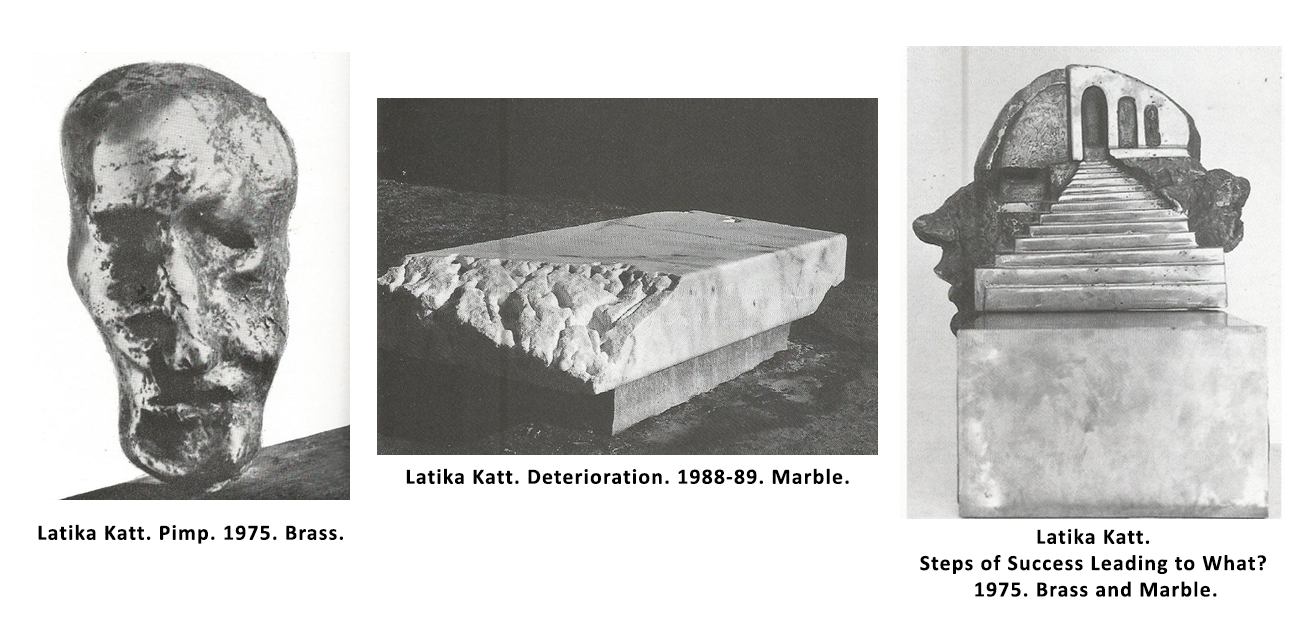
Mrinalini Mukherjee (1949-2015)
So far as original modernist form of sculpture derived from indigenous tradition is concerned Mrinalini Mukherjee stands apart in the sculptural scenario of modern India just after Meera Mukherjee. Meera derived her form from the heritage of ancient tribal craftsmen; Mrinalini did it from the popular tradition of knitting used since time immemorial for decoration of temples and household utility services. Hers is entirely a new mode of expression unique in global perspective too.
Mrinalini, the only daughter of the celebrated artists of Santiniketan Binodbehari Mukherjee and Leela Mukherjee, made her graduation in Fine Arts from M.S.University Baroda in 1970 and post-diploma in Mural Design in 1972 from the same institution. For her art education her father preferred Baroda to Santiniketan probably due to the fact that, as he felt, the revolutionary creative energy of Santiniketan manifested till the third decade twentieth century waned gradually after independence. Baroda projected Mrinalini’s creative genius towards an original aesthetic philosophy.
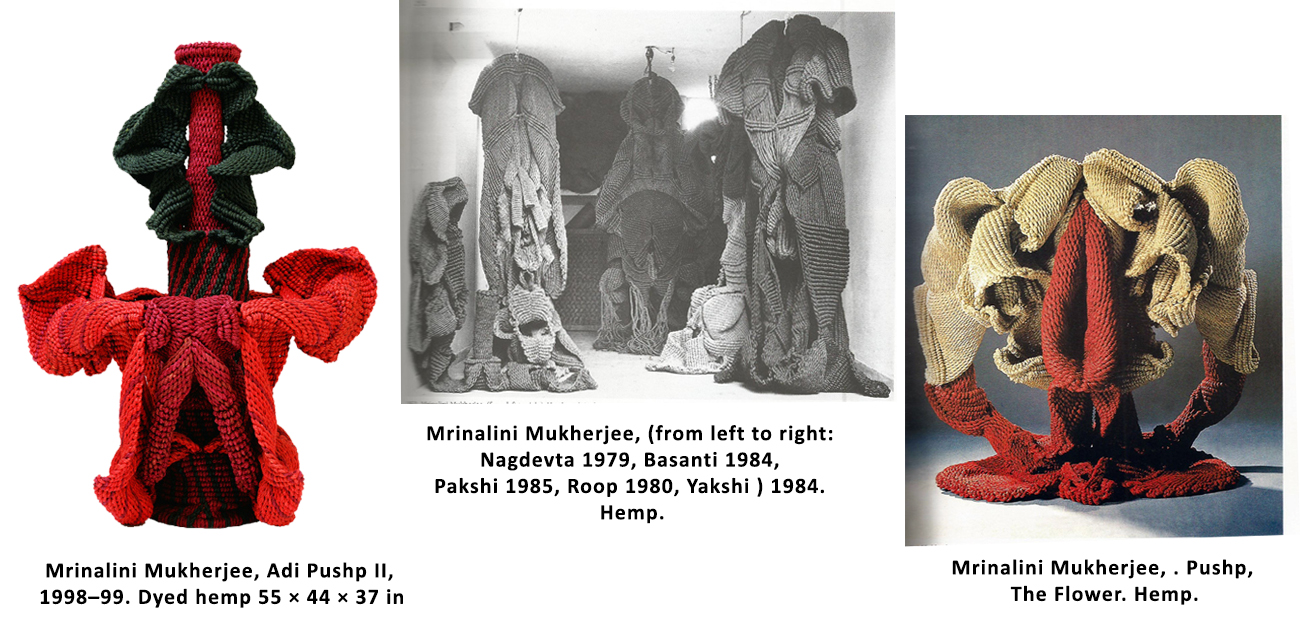
Her freestanding sculptures fabricated out of hemp that is drawn from local vegetative threads, show plant forms and humanoid figures that are sometimes grouped in installations akin to the cult shrines of earth deities. She does not like to connect her forms to any specific culture. She once said: ‘To me it is a feeling that I may get in a church, mosque, temple or forest. The countryside is filled with places where divinity dwells. … It is often a sense of space, scale or presence that gives me a secret feeling, and this could be anywhere in the world.’ (Lalit Kala Contemporary, 43, 2000, p-32). The titles of her works are significant, such as Yogini, Yakshi, Pusp, Vriksh-Nata, Nagdevta, Pakshi, Basanti etc indicating their link with primordial cultural tradition.
Other Sculptors of 1970-s
Among the other sculptors of seventies Anila Jacob (1941) of Tamilnadu and Gogi Saroj Pal (1945) of Delhi are well known. Jacob was born in Kerala. She made her diploma in Arts from Govt Art College of Madras. She got National Award of Lalit Kala Akademy in 1965 and participated in 2nd Triennale at Delhi. She was associated with Cholamandala Artists Village at Tamilnadu. Gogi Saroj Pal is a painter, print maker and sculptor. She was born in Delhi, took her art education from Govt Art College of Lucknow. She got national award in 1996 and participated in 5th and 8th Triennale in 1982 and 1994.
Among the other sculptors of Seventies there are Bhabsar Veerbala (1941) of Baroda, Mani Giduthiri Narayan (1943) of Mumbai, Toshi Chanala (1943) of Delhi, Mani Narayan (1943) of Mumbai, Saroj Jain (1944) of Haryana, Debendra Sashi Arora (1947) of Delhi, Manju Sharma Mishra (1950) of Rajasthan and others.
Sculptors of 1980-s
Number of women sculptors has increased during 1980-s. Among them three sculptors made considerable impact. They were Ratnabali Kant (1956) of Delhi, N.Pushpamala (1956) of Bangalore and Trupti Patel (1957) and Soma Chakraborty (1960-2017) of Kolkata.
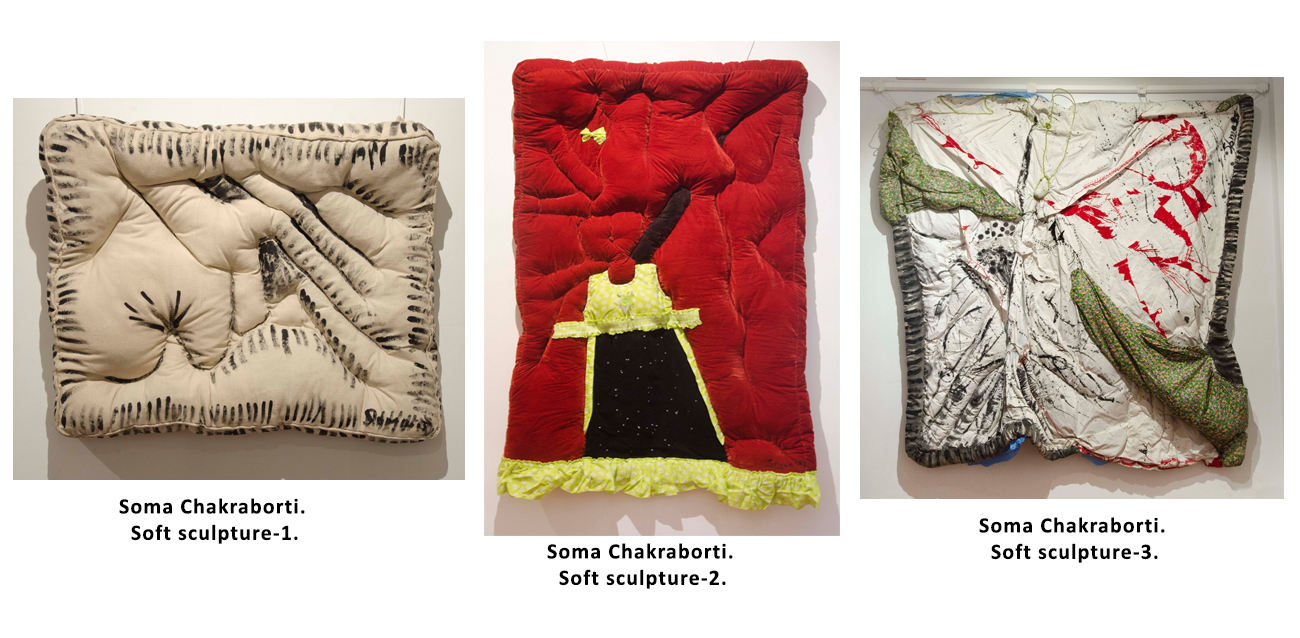
Soma developed a different kind of sculptural form. She made soft sculptures by means of stitching on layers of cloths or fabrics. Mrinalini Mukhopadhyay made one kind of soft sculptures. Soma’s forms were different. She derived her forms from the tradition of stitched patched cloth of village Bengal popularly known as ‘nakshi kantha’, and transformed it towards a different expression through which she conveyed her discontent about the dilapidated reality. Her forms of soft sculptures were unique and an important contribution in our contemporary sculpture. She made her post-graduation in Sculpture from Visvabharati Kalabhavana in 1985.
Ratnabali Kant made her graduation from Visvabharati Kalabhaban in 1977 and post-graduation from Baroda in 1979. She made higher research at Athens University of Greece from 1983 to 86. Assimilating sculpture and dance forms she developed different kind of installation, which was a unique contribution of her. Both Pushpamala and Trupti Patel made their post-graduationin sculpture from Baroda in 1985 and 1982 respectivly. In the first phase of their career they started with terracotta and then developed their own conceptual forms.
Conclusion
Here let us come to an end of our sojourn through the creativity of women sculptors of modern India. From Meera Mukherjee to Mrinalini Mukherjee and Soma Chakraborty the sculptural tapestry is, no doubt, enlightening and encouraging enshrining a feminine mode of viewing the life and time, which is very different from creativity of men-sculptors. The sculptural activity of women artists has expanded gradually after 1980s till the second decade of 21st century. We may require another lecture to cover the field.

